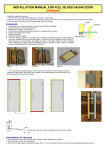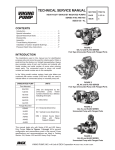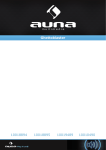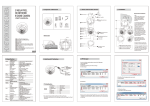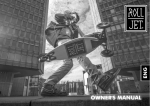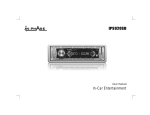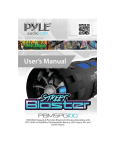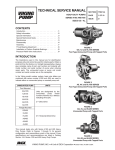Download TECHNICAL SERVICE MANUAL
Transcript
TECHNICAL SERVICE MANUAL HEAVY DUTY PUMPS SERIES 4195 and 495 SERIES GG - AL SECTION TSM 144 PAGE 1 ISSUE B CONTENTS Introduction Special Information Special Mechanical Seals Maintenance Disassembly Assembly Thrust Bearing Adjustment Installation of Carbon Graphite Bushings Pressure Relief Valve Instructions 1 2 2 2 3 5 7 7 7 INTRODUCTION FIGURE 1 GG. HJ and HL 4195 SERIES Foot Type Unmounted Pump with Tapped Ports The illustrations used in this manual are for identification purposes only and cannot be used for ordering parts. Obtain a parts list from the factory or a Viking® representative. Always give complete name of part, part number and material with model number and serial number of pump w hen ordering repair parts. The unmounted pump or pump unit model number and serial number are on the nameplate secured to the pump. In the Viking model number system, basic size letters are combined with series number (4195 and 495), indicating both the unmounted or mounted pump units. Model Number Chart UNMOUNTED PUMP UNITS FIGURE 2 AS, AK and AL 4195 SERIES Foot Type Unmounted Pump with Tapped Ports Foot Mounted GG 4195 HJ 4195 HL 4195 AS 4195 AK 4195 AL 4195 Units Are Designed By The Un-Mounted Pump Model Numbers Followed By A Letter(s) Indicating Drive Style. D = Direct Drive Flange Mounted GG 495 M = Horizontal Direct Drive HJ 495 HL 495 FIGURE 3 GG. HJ and HL SIZE 495 SERIES Unmounted Pump with Tapped Ports IM = Vertical In Line Direct Drive AS 495 AK 495 AL 495 This manual deals only with Series 4195 and 495 Heavy Duty Pumps. Refer to Figures 1 thru 14 for general configuration and nomenclature used in this manual. Pump specifications and recommendations are listed in Catalog Section 144, Series 4195 and 495 Heavy Duty Pumps. VIKING PUMP INC. • A Unit of IDEX Corporation • FIGURE 4 AS, AK and AL SIZE 495 SERIES Unmounted Pump with Tapped Ports SPECIAL MECHANICAL SEALS SPECIAL INFORMATION This bulletin illustrates the mechanical seal which is standard in the catalog pump. A Seal Installation Drawing will be furnished with a pump fitted with a nonstandard mechanical seal. Consult this Seal Installation Drawing before disassembling pump. DANGER BEFORE OPENING ANY VIKING PUMP LIQUID CHAMBER (PUMPING CHAMBER, RESERVOIR, RELIEF VALVE ADJUSTING CAP FITTING ETC.) BE SURE: 1. THAT ANY PRESSURE IN CHAMBER HAS BEEN COMPLETELY VENTED THROUGH SUCTION OR DISCHARGE LINES OR OTHER APPROPRIATE OPENINGS OR CONNECTIONS. 2. THAT THE DRIVING MEANS (MOTOR, TURBINE, ENGINE, ETC.) HAS BEEN “LOCKED OUT” OR MADE NON OPERATIONAL SO THAT IT CANNOT BE STARTED WHILE WORK IS BEING DONE ON PUMP. Modifications are required to install Teflon seals in these pumps. Contact factory for specific information. RELIEF VALVE ADJUSTING SCREW CAP SUCTION DISCHARGE FIGURE 5 3. THAT YOU KNOW WHAT LIQUID THE PUMP HAS BEEN HANDLING AND THE PRECAUTIONS NECESSARY TO SAFELY HANDLE THE LIQUID. OBTAIN A MATERIAL SAFETY DATA SHEET (MSDS) FOR THE LIQUID TO BE SURE THESE INFORMATION PRECAUTIONS ARE SPECIAL UNDERSTOOD. MAINTENANCE Series 4195 and 495 pumps are designed for long, troublefree service life under a wide variety of application conditions with a minimum of maintenance. The points listed below will help provide long service life. CLEANING PUMP: Keep pump as clean as possible. This will facilitate inspection, adjustment and repair work and help prevent overlooking a dirt covered grease fitting. FAILURE TO FOLLOW ABOVE LISTED PRECAUTIONARY MEASURES MAY RESULT IN SERIOUS INJURY OR DEATH. STORAGE: If pump is to be stored, or not used for six months or more, pump must be drained and a light coat of non-detergent SAE 30 weight oil must be applied to all internal pump parts. Lubricate fittings and apply grease to pump shaft extension. Viking suggests rotating pump shaft by hand one complete revolution every 30 days to circulate the oil. ROTATION: Viking pumps operate equally well in a clockwise or counterclockwise rotation. Shaft rotation determines which port is suction and which is discharge. Suction Port is where pumping elements (gear teeth) come out of mesh. SUGGESTED REPAIR TOOLS: The following tools must be available to properly repair Series 4195 and 495 pumps. These tools are in addition to standard mechanics’ tools such as open end wrenches, pliers, screw drivers, etc. Most of the items can be obtained from an industrial supply house. PRESSURE RELIEF VALVES: 1. Viking pumps are positive displacement pumps and must be provided with some sort of pressure protection. This may be a relief valve mounted directly on the pump, an inline pressure relief valve, a torque limiting device or a rupture disk. 1. Soft Headed hammer 2. A lIen wrenches (set screws & special mechanical seals) 2. There are relief valve options available on those pump models designed to accept a relief valve. Options may include a return to tank relief valve and a jacketed relief valve. Pumps equipped with a jacketed head plate are generally not available with a relief valve. 3. Snap Ring Pliers INTERNAL – Viking Part No. 2-810-047-999 GG-HJ-HL 4195-495 EXTERNAL – Viking Part No. 2-810-029-375 GG-HJ-HL 4195-495 3. If pump rotation is reversed during operation, pressure protection must be provided on both sides of pump. 4. Mechanical Seal Installation Sleeve 2-751-001-900 for 0.75 inch seal; GG 4195-495 2-751-004-900 for 1.25 inch seal; AS-AL 4195-495 4. Relief valve adjusting screw cap must always point towards suction side of pump. If pump rotation is reversed, remove pressure relief valve and turn end for end. Refer to Figure 5. 5. Bearing Locknut Spanner Wrench (Source: #471 J.H. Williams & Co. or equal) 5. Pressure relief valves should not be used to control pump flow or regulate discharge pressure. 6. Spanner Wrench, adjustable pin type for use on bearing housing end cap. (Source: #482 J.H. Williams & Co. or equal) For additional information on pressure relief valves, refer to Technical Service Manual TSM 000 and Engineering Service Bulletin ESB-31. 7. Brass bar 8. Arbor press 2 DANGER 1. Refer to figures 7 & 8 page 4 for model to be disassembled and name of parts. Models 4195 & 495 are disassembled and assembled the same. The difference between these models is the casings. BEFORE OPENING ANY VIKING PUMP LIQUID CHAMBER (PUMPING CHAMBER, RESERVOIR, RELIEF VALVE ADJUSTING CAP FITTING ETC.) BE SURE: 2. Mark head and casing before disassembly to insure proper reassembly. The idler pin, which is offset in the pump head, must be positioned up an equal distance between port connections to allow for proper flow of liquid through the pump. DISASSEMBLY 1. 2. 3. THAT ANY PRESSURE IN CHAMBER HAS BEEN COMPLETELY VENTED THROUGH SUCTION OR DISCHARGE LINES OR OTHER APPROPRIATE OPENINGS OR CONNECTIONS. 3. Remove the head capscrews. NOTE: The four valve capscrews, valve and gasket must be removed from the GG 4195-495 model before the six head capscrews are removed. 4. Tilt top of head back when removing to prevent idler from falling off idler pin. THAT THE DRIVING MEANS (MOTOR, TURBINE, ENGINE, ETC.) HAS BEEN “LOCKED OUT” OR MADE NON OPERATIONAL SO THAT IT CANNOT BE STARTED WHILE WORK IS BEING DONE ON PUMP. 5. Remove idler and bushing assembly. If idler bushing needs replacing, see “Installation of Carbon Graphite Bushings”, page 7. 6. Insert a brass bar or piece of hardwood in the port opening and between the rotor teeth to keep the shaft from turning. Turn the locknut counterclockwise and remove locknut. See Figure 9 or 10. THAT YOU KNOW WHAT LIQUID THE PUMP HAS BEEN HANDLING AND THE PRECAUTIONS NECESSARY TO SAFELY HANDLE THE LIQUID. OBTAIN A MATERIAL SAFETY DATA SHEET (MSDS) FOR THE LIQUID TO BE SURE THESE PRECAUTIONS ARE UNDERSTOOD. 7. Loosen two setscrews in face of bearing housing and turn thrust bearing assembly counterwise and remove from casing. See Figure 9 or 10. 8. GG, HJ, HL: Remove snap ring from shaft. See Figure 9. AS, AK, AL: Remove bearing spacer from shaft. See Figure 10. FAILURE TO FOLLOW ABOVE LISTED PRECAUTIONARY MEASURES MAY RESULT IN SERIOUS INJURY OR DEATH. 9. Remove brass bar or piece of hardwood from port opening. MECHANICAL SEAL HEAD IDLER ROTOR BALL BEARINGS PRESSURE RELIEF VALVE SHAFT SNAP RINGS IDLER PIN CASING HEAD GASKET FIGURE 6 - CUTAWAY OF MODELS GG, HJ, or HL 4195 3 Modifications to pump casing and rotor are required for installation of optional Teflon® Mechanical Seal. Consult the factory. FIGURE 7 – EXPLODED VIEW MODELS GG, HJ and HL 4195 and 495 ITEM 1 2 3 4 5 6 NAME OF PART ITEM Locknut Snap Ring, Outer Ball Bearing, Outer Snap Ring for Shaft * Bearing Housing Snap Ring, Inner 7 8 8A 9 10 11 NAME OF PART ITEM Ball Bearing, Inner Casing (4195) Casing (495) Pipe Plug Mechanical Seal Rotor and Shaft 12 13 14 15 16 17 NAME OF PART Idler Bushing Idler and Bushing Head Gasket Idler Pin Head and Idler Pin Capscrew for Head ITEM 18 19 20 NAME OF PART Gasket for Relief Valve Relief Valve Capscrew for Valve * NOT USED ON “GG” SIZE PUMPS Modifications to pump casing and rotor are required for installation of optional Teflon® Mechanical Seal. Consult the factory. FIGURE 8 – EXPLODED VIEW MODELS AS, AK and AL 4195 and 495 ITEM NAME OF PART ITEM NAME OF PART ITEM 1 2 3 4 5 6 Locknut Bearing Spacer Collar End Cap for Bearing Housing Lip Seal for Bearing Housing Ball Bearing, Outer Bearing Housing 7 8 9 10 10A 11 Bearing Spacer Ball Bearing, Inner Bearing Retainer Washer Casing (4195) Casing (495) Gasket for Re lief Valve 12 13 14 15 16 17 Teflon® - Registered Trademark of DuPont Dow Elastomers L.L.C. 4 NAME OF PART Relief Valve Pipe Plug Capscrew for Valve Rotor and Shaft Mechanical Seal Idler Bushing ITEM 18 19 20 21 22 23 NAME OF PART Idler and Bushing Head Gasket Idler Pin Check Valve Head and Idler Pin Capscrew for Head INNER BALL BEARING BALL BEARING INNER SNAP RING OUTER SNAP RING LOCKNUT SHAFT SHAFT SNAP RING BEARING HOUSING BALL BEARING FIGURE 9 – THRUST BEARING ASSEMBLY GG, HJ and HL SIZES BALL BEARING SETSCREW BEARING RETAINER WASHER INNER BALL BEARING NYLON INSERT END CAP LIP SEAL SHAFT BEARING SPACER LOCKNUT BEARING HOUSING SETSCREW FIGURE 10 – THRUST BEARING ASSEMBLY AS, AK and AL SIZES 10. The rotor and shaft can now be removed by tapping on end of shaft with a lead hammer or, if using a regular hammer, use a piece of hardwood between shaft and hammer. The rotary member of the seal will come out with rotor and shaft. 11. AS,AK,AL: 13. GG, HJ, HL: Remove inner snap ring and single row ball bearing from casing. AS, AK, AL: Remove single row ball bearing from casting. 14. Remove seal seat or stationary part of seal from casing. Remove bearing retainer w asher. The washer may have stayed with Rotor and Shaft when removed or is against ball bearing. See Figure 10. 15. Disassemble thrust bearing assembly. GG, HJ, HL: Remove outer snap ring from bearing housing and remove ball bearing. See Figure 9. AS, AK, AL: Loosen two set screws in flange outside diameter. Rotate end cap and lip seal counterclockwise and remove. Remove ball bearing. See Figure 10. 12. Remove the mechanical seal rotary member and spring from rotor and shaft assembly. 5 SPRING The casing should be examined for wear, particularly in the area between ports. All parts should be checked for wear before pump is put together. MECHANICAL SEAL (ROTARY MEMBER) When making major repairs, such as replacing a rotor and shaft; it is advisable to also install a new mechanical seal, head and idler pin, idler and bushing. See "Installation of Carbon Graphite Bushings" page 7. Clean all parts thoroughly and examine for wear or damage. Check lip seals, ball bearings, bushing and idler pin and replace if necessary. Check all other parts for nicks, burrs, excessive wear and replace if necessary. TAPERED SLEEVE COAT WITH LIGHT OIL BEFORE ASSEMBLY Wash bearings in clean solvent. Blow out bearings with compressed air. Do not allow bearings to spin; turn them slowly by hand. Spinning bearings will damage race and balls. Make sure bearings are clean, then lubricate with non-detergent SAE 30 weight oil and check for roughness. Roughness can be determined by turning outer race by hand. Replace bearings if bearings have roughness. FIGURE 11 ROTOR HUB SPRING MECHANICAL SEAL (ROTARY MEMBER) Be sure shaft is free from nicks, burrs and foreign particles that might damage mechanical seal. Scratches on shaft in seal area will provide leakage paths under mechanical seal. Use fine emery cloth to remove scratches or sharp edges. SHAFT ASSEMBLY Assembly Notes On Standard Mechanical Seal (Synthetic Rubber Bellows Type) FIGURE 12 READ CAREFULLY BEFORE REASSEMBLING PUMP 4. Place tapered installation sleeve on shaft, refer to Figure 11. Sleeve is furnished with GG, AS, AK and AL replacement mechanical seals. Coat rotor shaft, tapered installation sleeve and inner diameter of mechanical seal rotary member with a generous amount of non-detergent SAE 30 weight oil. Petrolatum may be used but grease is not recommended. The seal used in this pump is simple to install and good performance will result if care is taken during installation. The principle of mechanical seal is contact between the rotary and stationary members. These parts are lapped to a high finish and their sealing effectiveness depends on complete contact. 5. Place seal spring on shaft against rotor hub. Refer to Figure 12. Prior to installing rotary portion of mechanical seal, prepare and organize rotor shaft, head and idler assemblies and appropriate gaskets for quick assembly. 6. Slide rotary member, lapped contact surface facing away from spring, over installation sleeve on shaft until just contacting the spring. Do not compress spring. Remove installation sleeve. Once rotary portion of mechanical seal is installed on rotor shaft, it is necessary to assemble parts as quickly as possible to insure the seal does not stick to shaft in wrong axial position. The seat will stick to the shaft after several minutes setting time. 7. Coat rotor shaft with non-detergent SAE 30 weight oil. Install shaft slowly pushing until the ends of rotor teeth are just below the face of the casing. Never touch sealing faces with anything except clean hands or clean cloth. Minute particles can scratch the seal faces and cause leakage. 1. 2. 3. 8. Leave the rotor in this position. Withdrawal of rotor and shaft may displace the carbon seal rotating face and result in damage to the seal. Coat idler pin with non-detergent SAE 30 weight oil and place idler and bushing on idler pin in head. If replacing a carbon graphite bushing, refer to Installation of Carbon Graphite Bushings, page 7. 9. Place O-ring gasket on head and install head and idler assembly on pump. Pump head and casing were marked before disassembly to insure proper reassembly. If not, be sure idler pin, which is offset in pump head, is positioned up and equal distance between port connections to allow for proper flow of liquid through pump. Clean rotor hub and casing seal housing bore. Make sure both are free from dirt and grit. Coat outer diameter of seal seat and inner diameter of seal housing bore with non-detergent SAE 30 weight oil. 10. Tighten head capscrews evenly. 11. If pump was equipped with a relief valve and was removed during disassembly, install on head with new gaskets. Relief valve adjusting screw cap must always point towards suction port. Refer to Figure 5 page 2. For relief valve repair or adjustments, see PRESSURE RELIEF VALVE INSTRUCTIONS, Page 7. Start seal seat in seal housing bore. If force is necessary protect seal face with a clean cardboard disc and gently tap i1 in place with a piece of wood. Be sure seal seat is completely seated in the bore. 6 THRUST BEARING ADJUSTMENT 12. Pack inner ball bearing with multi-purpose grease, NLGI #2. GG, HJ, HL: See Figures 9 and 10. Install bearing in casing with sealed side towards head end of pump. Drive the bearing into the bore. Tap the inner race with a brass bar and lead hammer to position bearing.Install inner snap ring. Loosen two screws in face of thrust bearing assembly. If shaft cannot be rotated freely, turn thrust bearing assembly counterclockwise until shaft can be turned easily. AS, AK, AL: Install bearing retainer washer over the shaft before installing ball bearing. Install ball bearing in casing with sealed side towards head end of pump. Drive the bearing into the bore. Tap the inner race with a brass bar and lead hammer to position bearing. To set end clearance: 13. GG, HJ, HL: Install shaft snap ring in groove in the shaft. See Figure 9. AS, AK, AL: Install bearing spacer over shaft and against single row ball bearing. See Figure 10. 14. Pack lubrication chamber between inner ball bearing and double row ball bearing in the thrust bearing assembly approximately one-half full of multi-purpose grease, NLGI #2. The thrust bearing assembly will take the remaining space. See Figure 9 and 10. 15. Pack double row grease, NLGI #2. ball bearing with 1. While turning rotor shaft, rotate thrust bearing assembly cloc kwise until noticeable drag occurs. This is zero end clearance. 2. Mark position of bearing housing with respect to the casing. 3. Rotate thrust bearing assembly counterclockwise the distance listed below as measured on outside of bearing housing. 4. Tighten two setscrews in face of bearing housing after adjustment is made to secure thrust bearing assembly position. For viscosities above 2500 SSU, add additional end clearance (0.004” for GG, HJ and HL size pumps and 0.005” for AS, AK and AL size pumps). multi-purpose GG, HJ, HL: Install ball bearing into bearing housing with shield side toward coupling end of shaft. See Figure 9. Install snap ring into bearing housing to retain ball bearing. This snap ring has a tapered edge to fit tapered groove in bearing housing. The tapered edge is located away from ball bearing. AS, AK, AL: Install ball bearing into bearing housing. Install lip seal in bearing housing end cap. The lip should face towards end of shaft. Put bearing spacer collar in lip seal and install in bearing housing and tighten set screws securely. See Figure 10. 16. Insert brass bar or hardwood through port opening betw een rotor teeth to keep shaft from turning. Pump Size Distance In Inches On O.D. Of Bearing Housing End Clearance GG 0.44” .003 HJ, HL 0.56” .003 AS, AK, AL 0.5” .003 INSTALLATION OF CARBON GRAPHITE BUSHINGS 17. Start thrust bearing assembly into casing. Turn by hand until tight. This forces rotor against head. Replace and tighten locknut or shaft. When installing carbon graphite bushings, extreme care must be taken to prevent breaking. Carbon graphite is a brittle material and easily cracked. If cracked, the bushing will quickly disintegrate. Using a lubricant and adding a chamfer on the bushing and the mating part will help in installation. The additional precautions listed below must be followed for proper installation: 18. Remove brass bar or hardwood from port opening. 19. Adjust pump end clearance, refer to page 7. DANGER 1. A press must be used for installation. BEFORE STARTING PUMP, BE SURE ALL DRIVE EQUIPMENT GUARDS ARE IN PLACE. 2. Be certain bushing is started straight. 3. Do not stop pressing operation until bushing is in proper position, starting and stopping will result in a cracked bushing. FAILURE TO PROPERLY MOUNT GUARDS MAY RESULT IN SERIOUS INJURY OR DEATH. 4. Check bushing for cracks after installation. 7 PRESSURE RELIEF VALVE INSTRUCTIONS DISASSEMBLY DANGER BEFORE OPENING ANY VIKING PUMP LIQUID CHAMBER (PUMPING CHAMBER, RESERVOIR, RELIEF VALVE ADJUSTING CAP FITTING ETC.) BE SURE: FIGURE 13 VALVE - GG, HJ, and HL SIZES VALVE - LIST OF PARTS 1. Valve Cap 6. Valve Body 2. Adjusting Screw 7. Valve Spring 3. Lock Nut 8. Poppet 4. Spring Guide 9. Cap Gasket 5. Bonnet 1. THAT ANY PRESSURE IN CHAMBER HAS BEEN COMPLETELY VENTED THROUGH SUCTION OR DISCHARGE LINES OR OTHER APPROPRIATE OPENINGS OR CONNECTIONS. 2. THAT THE DRIVING MEANS (MOTOR, TURBINE, ENGINE, ETC.) HAS BEEN “LOCKED OUT” OR MADE NON OPERATIONAL SO THAT IT CANNOT BE STARTED WHILE WORK IS BEING DONE ON PUMP. 3. THAT YOU KNOW WHAT LIQUID THE PUMP HAS BEEN HANDLING AND THE PRECAUTIONS NECESSARY TO SAFELY HANDLE THE LIQUID. OBTAIN A MATERIAL SAFETY DATA SHEET (MSDS) FOR THE LIQUID TO BE SURE THESE PRECAUTIONS ARE UNDERSTOOD. FAILURE TO FOLLOW ABOVE LISTED PRECAUTIONARY MEASURES MAY RESULT IN SERIOUS INJURY OR DEATH. Mark valve and head before disassembly to insure proper reassembly. 1. Remove valve cap. 2. Measure and record length of extension of adjusting screw. Refer to “A” on Figures 13 and 14. 3. Loosen locknut and back out adjusting screw until spring pressure is released. 4. Remove bonnet, spring guide, spring and poppet from valve body. Clean and inspect all parts for wear or damage and replace as necessary. ASSEMBLY FIGURE 14 VALVE – AS, AK and AL SIZES Reverse procedures outlined under Disassembly. If valve is removed for repairs, be sure to replace in same position. Relief valve adjusting screw cap must always point towards suction side of pump. If pump rotation is reversed, remove relief valve and turn end for end. Refer to Figures 5, page 2. VALVE - LIST OF PARTS 1. Valve Cap 6. Valve Body 2. Adjusting Screw 7. Valve Spring 3. Lock Nut 8. Poppet 4. Spring Guide 9. Cap Gasket 5. Bonnet 10. Bonnet 8 TECHNICAL SERVICE MANUAL SECTION TSM144 PAGE 9 ISSUE B HEAVY DUTY PUMPS SERIES 4195 and 495 SERIES GG - AL DANGER BEFORE STARTING PUMP, BE SURE ALL DRIVE EQUIPMENT GUARDS ARE IN PLACE. FAILURE TO PROPERLY MOUNT GUARDS MAY RESULT IN SERIOUS INJURY OR DEATH. PRESSURE ADJUSTMENT If a new spring is installed or if pressure setting of pressure relief valve is to be changed from that which the factory has set, the following instructions must be carefully followed. 1. Carefully remove valve cap which covers adjusting screw. Loosen locknut which locks adjusting screw so pressure setting will not change during operation of pump. 2. Install a pressure gauge in discharge line for actual adjustment operation. 3. Turn adjusting screw in to increase pressure and out to decrease pressure. 4. With discharge line closed at a point beyond pressure gauge, gauge will show maximum pressure valve will allow while pump is in operation. IMPORTANT In ordering parts for pressure relief valve, always give model number and serial number of pump as it appears on nameplate and name of part wanted. When ordering springs, be sure to give pressure setting desired. VIKING PUMP INC. • A Unit of IDEX Corporation • WARRANTY Viking warrants all products manufactured by it to be free from defects in workmanship or material for a period of one (1) year from date of startup, provided that in no event shall this warranty extend more than eighteen (18) months from the date of shipment from Viking. If, during said warranty period, any products sold by Viking prove to be defective in workmanship or material under normal use and service, and if such products are returned to Viking’s factory at Cedar Falls, Iow a, transportation charges prepaid, and if the products are found by Viking to be defective in workmanship or material, they will be replaced or repaired free of charge, FOB. Cedar Falls, Iowa. Viking assumes no liability for consequential damages of any kind and the purchaser by acceptance of delivery assumes all liability for the consequences of the use or misuse of Viking products by the purchaser, his employees or others. Viking will assume no field expense for service or parts unless authorized by it in advance. Equipment and accessories purchased by Viking from outside sources which are incorporated into any Viking product are warranted only to the extent of and by the original manufacturer’s warranty or guarantee, if any. THIS IS VIKING’S SOLE WARRANTY AND IS IN LIEU OF ALL OTHER WARRANTIES, EXPRESSED OR IMPLIED, WHICH ARE HEREBY EXCLUDED, INCLUDING IN PARTICULAR ALL WARRANTIES OF MERCHANTABILITY OR FITNESS FOR A PARTICULAR PURPOSE. No officer or employee of IDEX Corporation or Viking Pump, Inc. is authorized to alter this warranty. VIKING PUMP INC. • Copyright© 2000 •









